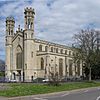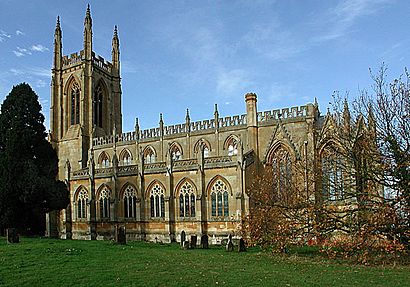List of new churches by Thomas Rickman facts for kids
Thomas Rickman (1776–1841) was a talented English architect who taught himself everything he knew about building design. He worked in cities like Liverpool and Birmingham. Rickman is most famous for designing many new churches, especially in the Gothic Revival style. This style brought back the look of old medieval churches. He also helped fix up and add to existing churches. Besides churches, he designed other buildings too, such as large country homes, public buildings, schools, and banks.
Contents
Who Was Thomas Rickman?
Thomas Rickman was born in Maidenhead, Berkshire. He first studied medicine and worked as a doctor for a short time. But he didn't stick with it. He then worked in London and later moved to Liverpool in 1808 as an insurance clerk. During this time, he became very interested in Gothic buildings.
While in Liverpool, he met John Cragg, who owned a factory that made things from iron. Together, they designed three churches using lots of cast iron for both the structure and decoration. Rickman then helped redesign Scarisbrick Hall. In 1817, he opened his own architecture office in Liverpool. A year later, Henry Hutchinson joined him, first as a student, then as a partner.
Rickman's Famous Book
In 1817, Rickman published a very important book called An Attempt to Discriminate the Styles of English Architecture. In this book, he neatly divided English architecture into different styles. These styles are still used by experts today! They include:
- Norman (from around 1066 to 1189)
- Early English (from around 1189 to 1307)
- Decorated (from around 1307 to 1377)
- Perpendicular (from around 1377 to 1547)
This book helped people understand and appreciate the history of English buildings much better.
Designing Churches Across England
Rickman later started working with the Church Commissioners. This group was responsible for building many new churches across England. Rickman designed several of these "Commissioners' churches." His first one was St George's Church in Birmingham.
In 1820, he opened an office in Birmingham and moved there with Henry Hutchinson the next year. He stayed in Birmingham for the rest of his career. Around this time, he became the architect for Worcester Cathedral. Soon after, he and Hutchinson began their biggest project: New Court at St John's College, Cambridge.
In 1830, Rickman was chosen to join the Society of Antiquaries of London. This showed that he was now fully accepted as a leading architect. Henry Hutchinson passed away in 1831. Later that year, R. C. Hussey joined Rickman's practice and became a partner in 1835. Thomas Rickman died in 1841.
Thomas Rickman's New Churches
This list shows some of the new churches designed by Thomas Rickman. Many of these churches are still standing and are important historical buildings.
Understanding Building Grades
Buildings in England are given special "grades" to show how important they are.
| Grade | What it means | ||||||||||||
|---|---|---|---|---|---|---|---|---|---|---|---|---|---|
| Grade I | These are buildings that are super special and important, sometimes even known around the world. | ||||||||||||
| Grade II* | These buildings are very important and have more than just a special interest. | ||||||||||||
| Grade II | These buildings are important to the country and have special historical interest. | ||||||||||||
| "—" means the building is not graded. | |||||||||||||
List of Churches
| Name | Location | Photograph | Date | Notes | Grade |
|---|---|---|---|---|---|
| St George's Church | Everton, Liverpool, Merseyside |  |
1813–14 | Built with John Cragg, using lots of cast iron from his factory. | I |
| St Michael's Church | St Michael's Hamlet, Liverpool, Merseyside |  |
1814 | Also built with John Cragg, using lots of cast iron. | I |
| St Philip's Church | Liverpool, Merseyside | 1815–16 | Built with John Cragg, using lots of cast iron. It was taken down in 1882. | ||
| St George's Church | Birmingham, West Midlands | 1819–21 | This church was taken down. Only its gates and gate posts remain and are listed. | II | |
| St Mary's Church | Birkenhead, Merseyside | 1821 | The church was no longer used in 1975 and parts of it were taken down. | II | |
| St Barnabas' Church | Erdington, Birmingham, West Midlands |  |
1822–23 | This was one of the "Commissioners' churches." | II |
| St George's Church | Chorley, Lancashire |  |
1822–25 | Another Commissioners' church. | II* |
| St Peter's Church | Preston, Lancashire | 1822–25 | A Commissioners' church, designed with Henry Hutchinson. Now part of the University of Central Lancashire. | II* | |
| Church of St Peter ad Vincula | Hampton Lucy, Warwickshire |  |
1822–26 | Designed with Henry Hutchinson. People say this was their most important work. | I |
| St Mary's Church | Mellor, Lancashire | 1825–27 | A Commissioners' church, designed with Henry Hutchinson. | II | |
| St Andrew's Church | Ombersley, Worcestershire |  |
1825–29 | Designed with Henry Hutchinson for the Marchioness of Downshire. | II* |
| St Thomas' Church | Birmingham, West Midlands | 1826–29 | A Commissioners' church, designed with Henry Hutchinson in a neoclassical style. It was bombed in 1941, and only the front part remains. | II | |
| St Peter's Church | Darwen, Lancashire | 1827–29 | A Commissioners' church, designed with Henry Hutchinson. | II* | |
| St John the Evangelist's Church | Oulton, West Yorkshire |  |
1827–29 | Designed with Henry Hutchinson. | II* |
| Holy Trinity Church | Lawrence Hill, Bristol |  |
1829–32 | A Commissioners' church designed with Henry Hutchinson. It is no longer used as a church. | II* |
| St Mary's Church | Tiddington, Oxfordshire |  |
1830 | A small church for the Hon. Frederick Bertie. | II |
| St John the Divine's Church | Pemberton, Wigan, Greater Manchester | 1830–32 | A Commissioners' church designed with Henry Hutchinson. | II | |
| St David's Church | Haigh, Greater Manchester |  |
1830–33 | A Commissioners' church designed with Henry Hutchinson. | II |
| St Mary's Church | Lower Hardres, Kent | 1831–32 | Designed with Henry Hutchinson. | II | |
| St Matthew's Church | Cotham, Bristol |  |
1833–35 | II | |
| Church of Our Lady of Mount Carmel | Redditch, Worcestershire | 1834 | II | ||
| All Saints Church | Stretton-on-Dunsmore, Warwickshire |  |
1835–37 | II* | |
| Church of the Holy Ascension | Settle, North Yorkshire |  |
1836–38 | II | |
| St. Stephen's Church | Sneinton, Nottingham | 1837–39 | Designed with R. C. Hussey. Only the tower and part of the south transept remain from their original design. | II | |
| Christ Church | Clevedon, Somerset | 1838–39 | Designed with R. C. Hussey. | II* |
Images for kids
See also
- List of church restorations and alterations by Thomas Rickman
- List of non-ecclesiastical works by Thomas Rickman










